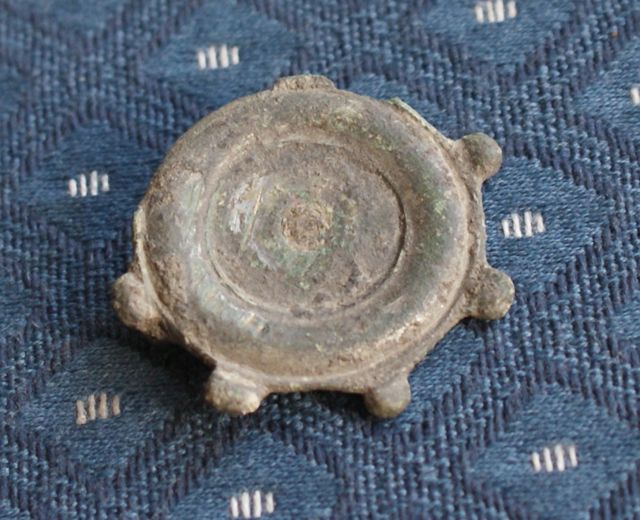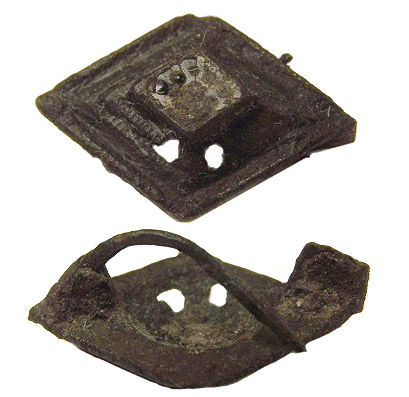These plate fibula have a solid plate in some sort of geometric form. Openwork plates or those in the form of animals or items are shown on other pages. Many of these plate fibulae, especially round ones, have a small semi-precious stone in the middle. If the stone is missing then there may be a small hole in the middle of the plate.
Typology: Riha 7.2.1; Ettlinger 39; Feugere 24a; Genceva 25b
Dates: Claudian - Flavian, c. AD 30/40 - 60/80
Distribution: Western Empire, especially Gaul

Image: Round plate fibula. This basic type has eight small knobs around the outside. The bulk of the plate was likely once silvered though no traces remain today. The small hole in the centre was to fix a small stone. (SC Collection)

Image: Round plate fibula. This basic type has eight small knobs around the outside. 32x32mm,10,39g. (Quadrans collection).

Image: Round Plate Fibulae, The surface is decorated with a series of small leaves (Niello inlaid disc brooch), with the central knob. Around the edge are eight small peripherial lugs. The hinge pin is missing. size: 26x26mm, weight: 5,79g. Date: mid and late 1st. centuries A.D.,(Quadrans collection).

Image: This round plate fibula has six small knobs on the circumference. While the outer and inner parts were plain copper the central band was silvered with a niello vine leaf decoration. Traces of the black niello can just be seen. The centre may have once had a small stone. (SC Collection)

Image: This round plate fibula had eight knobs around the circumference. The outer part of the circle is raised while the inner is flat. The entire surface was silvered. (SC Collection)

Image: Reverse of the above fibula. The back is flat despite the raised part of the front. Most of the original pin remains, held in a two-flange hinge. A small part of the catch across from the hinge can still be seen. Note the taper to the pin. (SC Collection)
Typology: Riha 7.2.1 var.
Dates: c. AD 30/40 - 70

Image: A rosette fibula made out of thin silver-plated brass sheet. The centre likely had a small stone but now only has some rust - the remains of a long-lost pin. (SC Collection)
Typology: Riha 7.4.1; Bojovic XXIII; Genceva 25a
Dates: Claudian - Flavian, c. AD40 - 70/80
Distribution: Origin in north Switzerland (Roman Raetia) but widespread finds.

Image: A typical rhomboid plate fibula. There is slight damage to the end of the left-hand arm and the central stone is missing. Much of the body was once silvered. (SC Collection)

Image: Reverse view of another rhomboid plate fibula. The iron pin can be seen as can the dual-flange hinge with small iron hinge-pin in place. Note how thin the pin is. There is also a the small hole that once held a small stone on the front of the fibula. (SC Collection)

Image: This rhomboid plate fibula is more of a diamond shape than the last example and is actually rarer than the type with the narrowing arms. The small stone (or ivory or bone) is still in place in the centre. This example may have been silvered. (SC Collection)

Image: Side view of the above fibula showing the small rounded stone still in place. The pin is missing though the hinge flanges and the catch are still in place. (SC Collection)

Image: A plainer rhomboid plate fibula with a plain diamond-shape decorated with a central lateral ridge. (SC Collection)

Image: Bronze
rhomboid stepped
brooch, 2nd century A.D., cf.
Hattatt BoA, 1085; cf. Malloy Auction LXI, May, 9, 2001, 1241; 28 mm long; finely made, diamond shape, without lugs, enamel diamond in center, stepped levels with incised lines, hinged pin, rear hollowed hemispherically;
complete with pin, two holes from corrosion;
rare without lugs. Appears to be from the same workshop as the referenced
Hattatt brooch, which was found in Britain. (ex
FORVM AS36059, ex Alex G.Malloy).
 Almgren
Almgren pl. 10, 227
 Almgren
Almgren pl. 10, 226
Typology: Ettlinger 41; Feugere 24d; Genceva 25c
Dates: Claudian - Flavian, c. AD 30/40 - 60/70
Distribution: Widespread, especially in Britain, Gaul, and Raetia.
Typology: Feugere 24d1; Riha 7.5

Image: Lunar plate fibula. It has a small white stone (or possibly ivory or bone knob) in the centre which has stained green from the copper verdigris. The upper right tip has broken. (SC Collection)

Image: Another lunar
plate fibula. The semi-precious stone in the centre is cracked and thus its red colour can be seen. Traces of
silvering remain on the plate. (Antiquities and Ancient Art collection.)
Typology: Feugere 24d2

Image: An eight pointed star pate fibula. It was likely once silvered. (SC Collection)

>Rectangular plate fibula. Possibly Roman 2nd century AD, possibly earlier Celtic.
Typology: Böhme 42e; Riha 7.6; Ettlinger 40; Feugere 24c; Genceva 25d
Dates: c. AD 40 - 100. Some remained in use to AD 120.
Distribution: Central and south France, western Switzerland
Typology: Genceva 25e
Dates: c. AD 50 - 110
Notes: This type has a small circular plate flanked by two dolphins.
Typology:
Schleiermachen 276-278
Notes: These fibula usually appear to be a mix of simpler geometric forms, i.e. a circle attached to a diamond, or a circle attached to a lunar form.

Image: This complex plate fibula consists of a large round part, with seven small knobs on the circumference and a small stone still in place, attached to a trapezoidal "foot" with two tiny corner knobs. (SC Collection)

Image: This complex plate fibula consists of a small circle, with three knobs around the circumference and a central knob or stone, attached to one narrowing "arm". It was likely once silvered. (SC Collection)

Image: Reverse of the above fibula showing the thin copper-alloy pin and the catch plate. (SC Collection)

Image: This complex plate fibula consists of a small circle, with three knobs around the circumference and a central knob or stone, attached to a divided fish-tail type form. (SC Collection)

Image: A flat complex plate fibula made up of a triangular arrow attached to a small circle. One of two tiny cross-bars remains in the middle. It is not entirely clear if this is an abstract design or is supposed to represent something (skeuomorphic) - perhaps a dagger or spearhead or other unknown symbol. (SC Collection)

Image: Another geometric plate complex shape plate fibula. 36x27mm, 6,02g. (Quadrans collection).
Equilateral Geometric Millefiori Enameled
Typology: BnF Bronzes 1778; Van Buchem, plate XV 7; Hattatt ABOA 1600, Figure 75 (similar millefiori)
Dates: 2nd Century A.D.

Image:
5 cm (2") long, symmetrical "equal ended" design, central raised rectangle, triangle ends, peripheral lugs, tiny millefiori enamelling with checkerboards, rosettes, stripes and concentric circles (ex FORVM AS34494).
References
Bohme, A. "Die Fibeln der Kastelle Saalburg und Zugmantel" in
Saalburg Jahrbuch, XXIX. (1972).
Bojovic, D.
Rimske Fibule Singidunuma. Muzej Grada Beograda Serija - Zbirke i Legati Katalog XII. (Beograd, 1983).
Ettlinger, E.
Die römischen Fibeln in der Schweiz. (
Bern, 1973).
Feugere, M. Les fibules en Gaule meridionale de la conquite a la fin du Ve sicle apres J.-C. (
Paris, 1985).
Available Online
Genčeva, E.
Les Fibules Romaines de Bulgarie de la fin du 1er s. av. J.-C. à la fin du VIe s. ap. J.-C. (Veliko Trnovo, 2004).
PDFRiha, E.
Die römischen Fibeln aus Augst und Kaiseraugst. (1979).
PDFSchleiermachen, M. "Die römischen Fibeln von Kempten-Cambodunum" in
Cambodunumforschungen V. (Kallmunz, 1993).
Van Buchem, H.
De Fibulae Van Nijmegen. (Nijmegen, 1941).
PDF

































